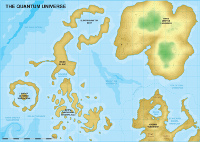 |
 |
|||||||||||||
|
|||||||||||||
|
|||||||||||||
|
When talking about what they know and what they want to find out, physicists like to speak about ‘landscapes’. There are the well-chartered lands of the Standard Model and undiscovered territories like the Terascale – a region that the Large Hadron Collider LHC at CERN will enter when protons start colliding in autumn. With the LHC and its eventful proton-proton collisions scientists expect a whole range of signatures of expected and new physics, and they will need a machine to follow up on these to get a clearer view. In February, a group of more than one hundred theorists and experimentalists met at CERN for three weeks. Their goal was to outline the landscapes they may find with data from the LHC and to develop strategies for how to pick the right tools for the coming expedition.
The ILC was one of several future particle physics projects discussed at the CERN theory institute "From the LHC to a Future Collider" – others are a planned luminosity upgrade of the LHC into 'sLHC,' the Compact Linear Collider study CLIC, a futuristic muon collider, the transformation of the LHC into a proton-electron collider called LHeC, or its upgrade to twice the energy, called DLHC. The participants – consisting to roughly 60 percent of theorists and 40 percent of experimentalists and accelerator experts – played through a number of scenarios of what the first data from the LHC might bring and what each of them would imply for future colliders. “We need the data from the LHC to make decisions on how to shape the future,” says Georg Weiglein from Durham University in the UK, one of the organisers of the Institute. “But once we have data and they point to certain features in the physics landscape, we have to be able to act quickly.” Four working groups looked at four different scenarios that could be seen from the first proton-proton collisions. “We think that we should be able to draw a first map after about ten inverse femtobarns of understood data. By some estimates that is about one year of good data taking at the LHC when running at nearly full energy,” explains Sven Heinemeyer from the Instituto de Física de Cantabria (a CSIC lab) in Spain, also one of the organisers. They played through the possibility that at this stage, the LHC shows signs of the Higgs boson or the possibility that the first data give no hints of the Higgs (“this could mean that nevertheless a Higgs boson exists but has properties that significantly differ from the ones predicted in the Standard Model – or it doesn't exist – which would imply other interesting new physics!” says Weiglein). They examined a scenario in which new physics is characterised by energy that goes missing from the collisions, which could be a sign for supersymmetry, and scenarios where the LHC shows signs of exotic and unpredicted things, and tried to match physics with accelerator, landscape with mapping tool. It wasn't all theory though: the experimentalist guests educated the theory hosts about accelerator technology. “We don't normally worry about things like bunch spacing,” says organiser James Wells from CERN. “We learned a lot!” If, for example, the Higgs boson shows up as a light particle somewhere in the early data, an electron-positron collider like the ILC would become extremely important because it could single out the much-desired particle and look at its characteristics in fine detail; it would be able to find deviations that would be too small for the LHC to see or signatures that would be too difficult to detect at the LHC. “Strong arguments for a 500-GeV linear collider to follow the LHC can arise in all four scenarios, even the second one with the missing Higgs, where it seems less obvious,” concludes Weiglein. “But there are also arguments for other options, and all possible future colliders are interesting from a physics point of view.” The organisers plan to publish a CERN 'yellow report' with the results from their Institute in the course of the year in which all four scenario design groups will write up their conclusions. -- Barbara Warmbein |
|||||||||||||
| © International Linear Collider |

